
The Slate Islands are a small archipelago in Lake Superior, Ontario, Canada, about 12 kilometres (7.5 mi) south of the town of Terrace Bay. The island group, consisting of 15 islands in total, was created by a meteorite impact which formed a crater about 32 km (20 mi) wide. In 1985, the Ontario government established the Slate Islands as a natural environment provincial park. The islands are notable for having Ontario's largest herd of boreal woodland caribou.
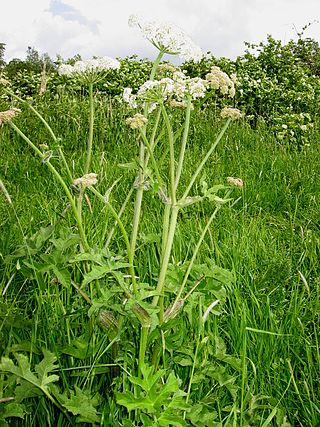
Heracleum sphondylium, commonly known as hogweed or common hogweed, is a herbaceous perennial plant in the carrot family Apiaceae, which includes fennel, cow parsley, ground elder and giant hogweed. It is native to most of Europe, western Asia and northern Africa, but is introduced in North America and elsewhere. Other common names include cow parsnip or eltrot. The flowers provide a great deal of nectar for pollinators.

Erythronium dens-canis, the dog's-tooth-violet or dogtooth violet, is a bulbous herbaceous perennial flowering plant in the family Liliaceae, growing to 25 cm (10 in). It is native to central and southern Europe from Portugal to Ukraine. It is the only naturally occurring species of Erythronium in Europe. Despite its common name, it is not closely related to the true violets of genus Viola.
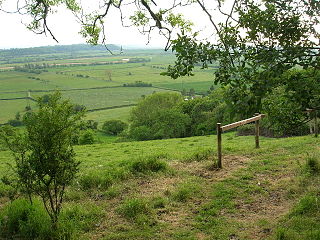
Aller Hill is an 18.4 hectare biological Site of Special Scientific Interest near Aller in Somerset, notified in 1988.
In botanical nomenclature, autonyms are automatically created names, as regulated by the International Code of Nomenclature for algae, fungi, and plants that are created for certain subdivisions of genera and species, those that include the type of the genus or species. An autonym might not be mentioned in the publication that creates it as a side-effect. Autonyms "repeat unaltered" the genus name or species epithet of the taxon being subdivided, and no other name for that same subdivision is validly published. For example, Rubus subgenus Eubatus is not validly published, and the subgenus is known as Rubus subgen. Rubus.

Veronicastrum sibiricum, the Sibirian veronicastrum, is a plant in the plantain family Plantaginaceae.

Diplazium sibiricum, otherwise known as the Mole-Ladder is a species of fern. It is found in Siberia, across Russia, in Finland, and in northern Asia. They can be found on elevations between 30m-3000m.

Trisetum is a genus of plants in the grass family, widespread in temperate, subarctic, and alpine habitats in much of the world. Oatgrass is a common name for plants in this genus.
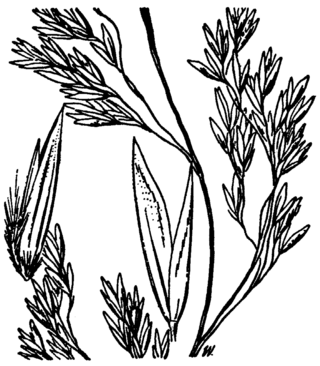
Graphephorum is a genus of North American plants in the grass family.
Filifolium is a genus of flowering plants in the daisy family.

Myriophyllum sibiricum is a species of water milfoil known by the common names shortspike watermilfoil, northern watermilfoil, and Siberian water-milfoil. It is native to Russia, China, and much of North America, where it grows in aquatic habitat such as ponds and streams. It generally grows over a meter long, its green stem drying white. It is lined with whorls of fanlike green leaves divided into many narrow, feathery lobes.

Erythronium sibiricum is a bulbous perennial plant in the lily family Liliaceae, commonly known as the Siberian fawn lily or Siberian trout lily.

Trisetum flavescens, the yellow oatgrass or golden oat grass, is a species of grass in the family Poaceae. It is native to Europe, Asia, and North Africa.

Trisetum canescens is a species of grass known by the common names tall trisetum and tall false oat.
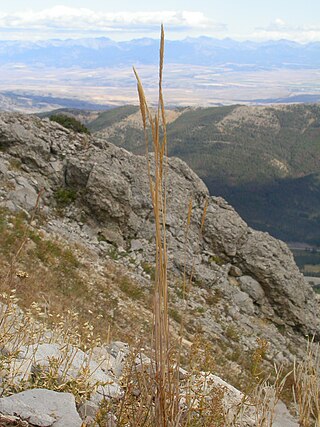
Trisetum spicatum is a species of grass known by the common name spike trisetum and spike false oat. It is native to North America, Eurasia, and South America. In North America it occurs throughout northern regions, including northern sections of the United States and most all of Canada, its range continuing to Greenland. It is widespread throughout the Canadian Arctic Islands. The grass occurs in a variety of Arctic and alpine habitat types, as well as many types of mountainous habitat in regions farther south. It is a perennial grass forming clumps of erect stems ranging in height from just a few centimeters to over one meter. The narrow leaves are mostly located around the bases of the densely clumped stems. The inflorescence is a narrow spike a few centimeters long or up to 30 to 50 centimeters in maximum length. The spikes are green to purple or brownish and shiny.
sibiricum is a species name, "of Siberia." Some genera associated with this name are:

Veronicastroside is a flavone, a type of flavonoid. It is the 7-O-neohesperidoside of luteolin. It can be found in Veronicastrum sibiricum var. japonicum and in Teucrium gnaphalodes.
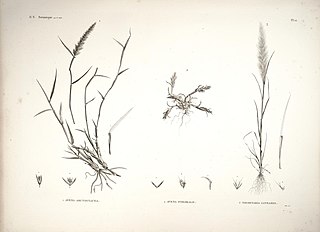
Trisetaria is a genus of plants in the grass family, native to Asia and to the Mediterranean region.














